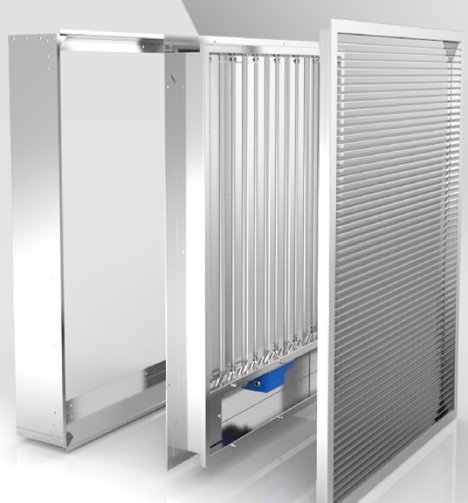In order to install the correct smoke ventilation system in a residential building, it is important to size the vents (also known as AOVs') correctly, otherwise the system will not be compliant.
In residential buildings, the most common approaches to smoke control are natural ventilation and/or mechanical smoke ventilation systems. With natural ventilation, automatic opening vents installed on either the side or roof of the building will open when triggered to allow smoke to escape from the building - they act very much in the same way as opening a regular window would. With mechanical ventilation systems, powered vents actively pull smoke out of the area they are installed to protect in the event of a fire.
There are different approaches to sizing vents for each of these solutions. In this blog, we will cover the guidance from Approved Document B and also provide some advice from our designers.
Taken from Approved document B, para 3.49-3.54:In England and Wales, you should make sure that the building needs smoke vents by checking against Approved Document B to the building regulations. If the building does not comply with Diagram 3.9 of approved document B, every corridor or lobby next to each stair should have a smoke vent.
The vent needs to be:
- As high as practicable
- Positioned so the top edge is at least as high as the top of the door to the stair
For buildings incorporating natural smoke ventilation, the building must comply to one of the following:
- The smoke vent should be located on an external wall with a minimum free area of 1.5m²
The smoke vent should discharge into a vertical smoke shaft, closed at the base, meeting all of the following criteria:
The shaft should conform to the following conditions:
- Have a minimum cross-sectional area of 1.5m² (minimum dimension 0.85m in any direction)
- Open at roof level, a minimum of 0.5m above any surrounding structures within 2m of it horizontally
- Extend a minimum of 2.5m above the ceiling of the highest story served by the shaft
The free area of all the following vents should be a minimum of 1m² in the following places:
- From the corridor or lobby into the shaft
- At the opening at the head of the shaft
- At all internal locations within the shaft (e.g safety grilles)
- A vent to the outside with a minimum free area of 1m² should be provided at the top of the staircase.
Natural ventilation sizing guidance from Colt:
For a residential smoke control system using natural ventilation, Colt will typically use a 1000x1700 (millimetres) smoke vent into the smoke shaft to achieve the minimum free area required of 1.5m². Therefore, this requires a smoke shaft that has at least 1m in width as the hole that the vent goes into is 1000x1700mm. For reference there is a render of one below.

- A typical vent Colt uses to go on a wall to the outside is a “Coltlite CLT” automatic louvred vent. For 1.5m² free area this would be sized approximately 1000x1900mm.
- For head of shaft vents, Colt will typically use a “Seefire” vent.
- For head of stair we have a range of products that could be suitable, depending on the architectural, aesthetic, or access requirements. Examples are: “Seefire” vents, AXS 140 vents (for rooftop access, comes in 2 different sizes) or Airlite ventilators.
All of these vents comply to the relevant standards, and are CE marked in accordance with BS EN 12101-8. Colt will not install vents that do not meet BS EN 12101-8 into locations that require such a vent.
Mechanical ventilation sizing guidance from Colt:
Mechanical ventilation systems are typically used where natural ventilation is not feasible. This might be because there is no wall in the lobby that connects to the external façade of the building, or because there is not enough space for natural ventilation, such as not having enough space for a full-size smoke shaft. It is normally made up of a natural shaft with extract fans at the top that suck smoke out of the lobbies.
There is not really a minimum size that mechanical vents can be, due to the nature of the system being a replacement where natural is not feasible for whatever reason. However, the smaller they are the quicker smoke travels across them, and it is recommended to not exceed 5m³/s across the vent. Typically, mechanical smoke vents that Colt install are about 800x600mm or larger. But it is project dependent and Colt designers and technical consultants will advise the best size for a mechanical system based on the performance objects and project constraints.
Additional guidance from BS 9991 to bear in mind when selecting a smoke control system for residential buildings
Mechanical smoke ventilation systems should be shown to demonstrate conditions in the lobby or corridor that are equivalent to (or better than) the natural ventilation system it replaces. This is normally done through Computational fluid dynamics analysis.
A mechanical smoke ventilation system using a shaft should be in accordance with:
- The smoke shaft should be fully open to the external air at the top and closed at the base
- The top of the lobby or corridor vent should be located as close to the ceiling of the lobby or corridor as practicable, and should be at least as high as the top of the door connecting the lobby or corridor to the stairwell.
- The lobby or corridor vents, in the closed position, should have a minimum fire and smoke resistance performance of 30 min and integrity (leakage) no greater than 360 m³/h/m² when tested in accordance with BS EN 1366-2
- No services other than those relating to the smoke shaft should be contained within the smoke shaft
- The smoke shaft should be located at the remote end of the corridor away from the staircase
Each of the above points also apply to natural smoke shafts.
In summary:
- Ensure your building layout and construction complies with Approved document B and British Standards
- Pick the smoke ventilation system most relevant to your building
- For an ADB natural smoke shaft of 1.5m² area and 0.85m minimum in any direction. Anticipate Colt smoke vents on each floor to be 1000x1700, or close to this size.
- For a natural ventilation system with AOVs to the outside in each lobby, anticipate the Colt vent to be approximately 1000x1900, depending on opening constraints. 1.5m² is the minimum free area, but the vent needs to be larger than 1.5m² to achieve that free area.
- For a mechanical system, consult Colt to determine the best size for your vents. You will still need a 1m² free area AOV at the head of the staircase.
Colt's technical consultants and designers are on hand to help you size vents correctly. If you need help, contact us.
 Conor Logan is Associate Technical Director of Colt UK, Smoke and Climate Control Division. Conor designs innovative smoke control and HVAC systems and was Chairman of the Smoke Control Association for over 9 years.
Conor Logan is Associate Technical Director of Colt UK, Smoke and Climate Control Division. Conor designs innovative smoke control and HVAC systems and was Chairman of the Smoke Control Association for over 9 years.


